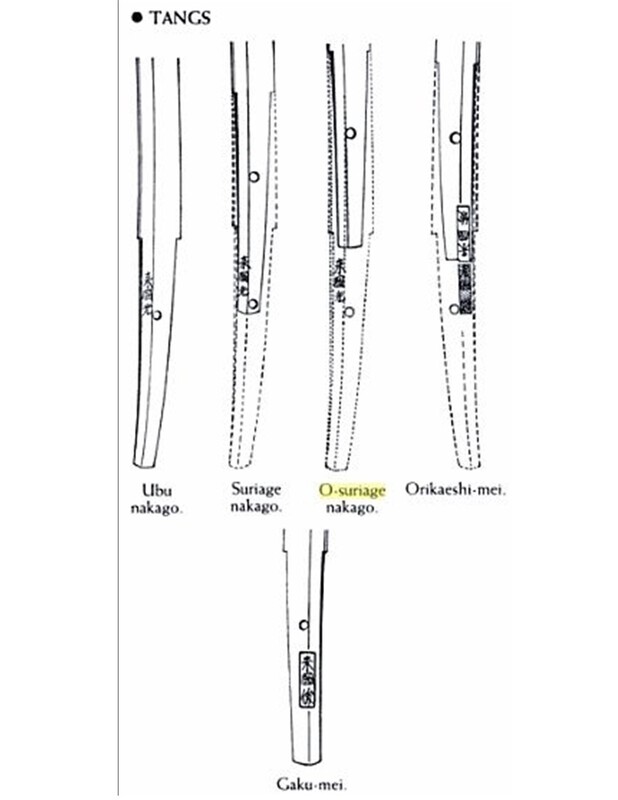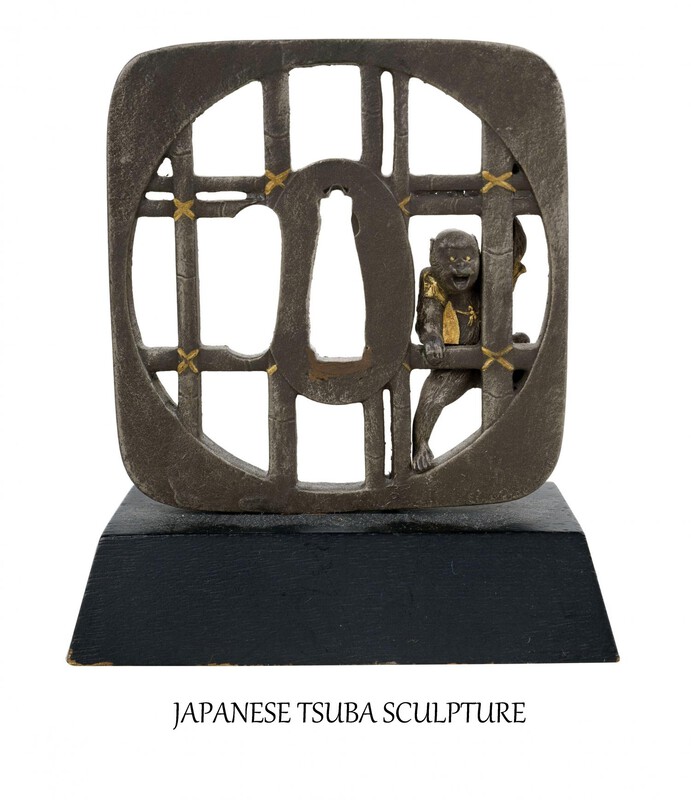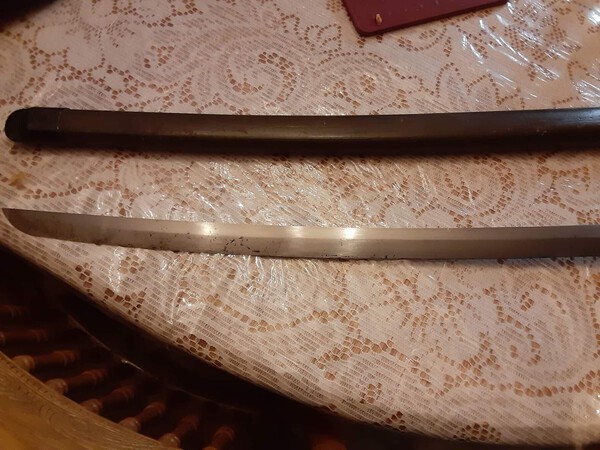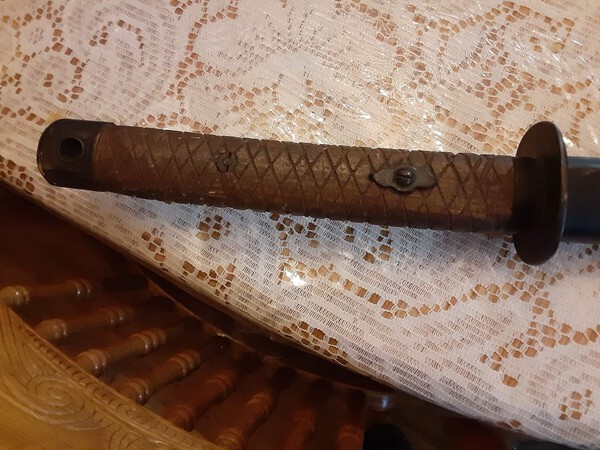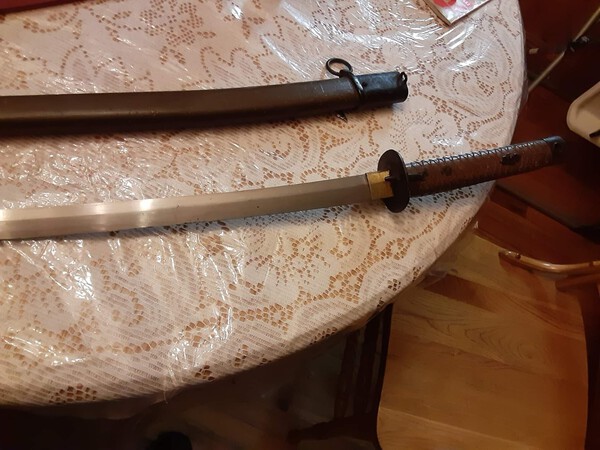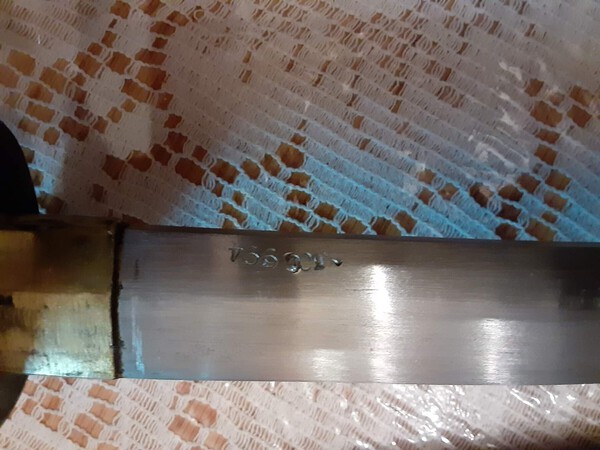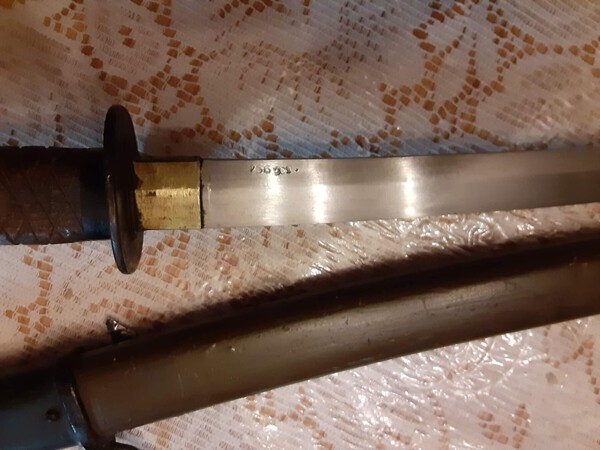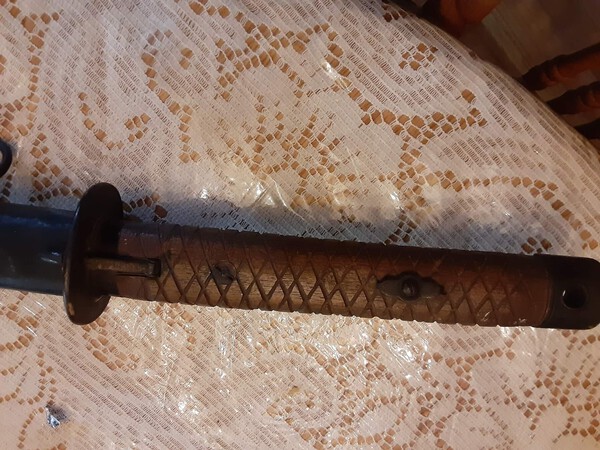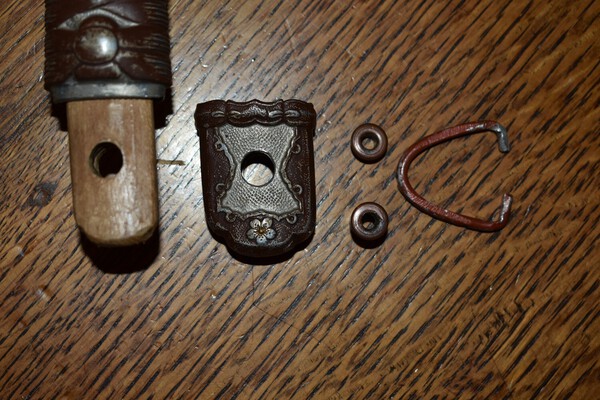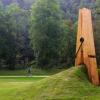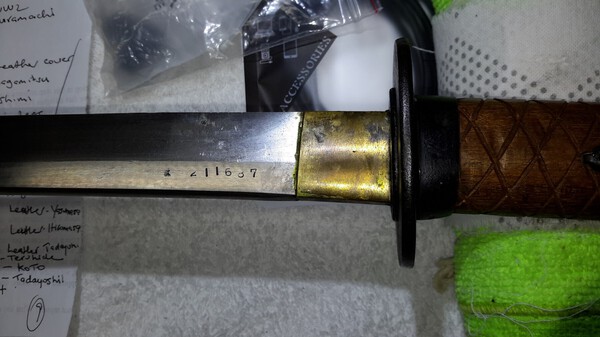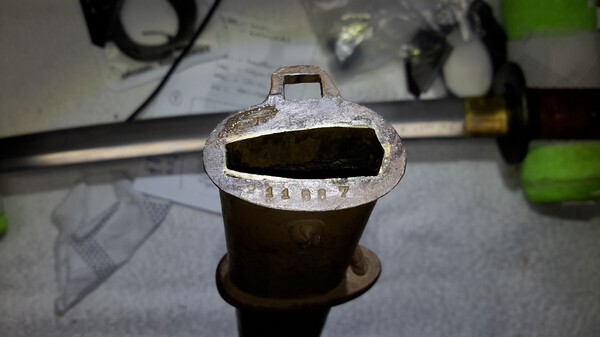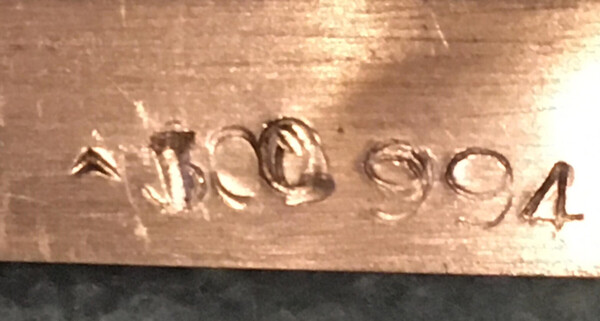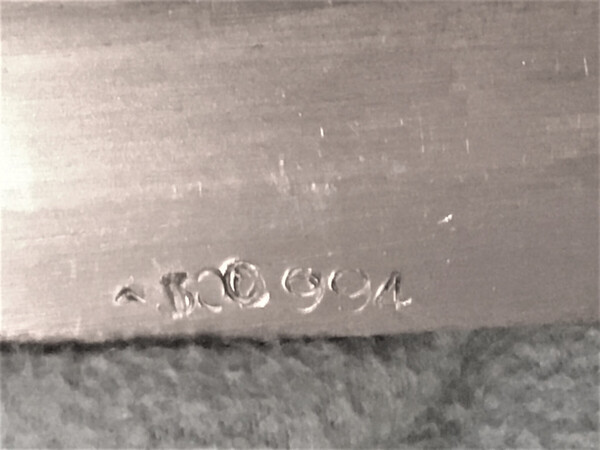Leaderboard
Popular Content
Showing content with the highest reputation on 06/21/2022 in all areas
-
I'm using this post as an opportunity to share a picture of my contribution. The original template for this piece is probably an Akasaka Tsuba. The flowing design represents a Waka poem from the Kokon Waka Shu 古今和歌集: ほのぼのと明石のうら朝ぎりの島かくれゆくふねをしぞおもふ "In the bay, of Akashi, when the day is drawing to an end, my thoughts follow a boat which disappears behind an island in the mist." Thanks Christoph6 points
-
It won't be numbered on the saya. It is the pattern 6 which had a wooden scabbard with unstamped, sheet-metal throat. They start at 300,000 serial range and are stamped on the blade. Best you'll likely find for stamps on the saya are the little, inverted ticks, as with the blade (that's what is after the number, thanks Bruce for the better pic). Just to confuse things, I have seen ONE single pattern 6 with a numbered throat before. But I didn't buy it so never got a good look). What you have posted, Rob, is the far more common pattern 5 with metal scabbard. Here are comparison pictures from Ohmura.5 points
-
A topic already long debated. I'm sceptical, others aren't. I've already presented a logical argument covering the points I think most meritorious in a previous thread and won't repeat it here, unless someone can find that thread so it's a simple copy paste job. I'm going to say it as clearly as I can here. There was a shortage of swords. Some early NCO were privately sold due to this shortage. Most were issued equipment, owned by the Emperor, not owned by the officers. There is ZERO primary evidence of privately owned blades being fitted in NCO mounts. Not one account I've seen, nothing. No photo. Nothing in archives, accounts, period news papers etc. There are a number of such swords in existence. Some are crude hatchet jobs, other like this very good, though lacking a habaki. It's entirely a matter of opinion and in no way can anyone claim otherwise, UNLESS new evidence has been found to show it was common or even the rarest practice. Some would have you believe otherwise, but it's all conjecture.4 points
-
Thank you Colin I'm referring to the tsuba in Glen's post, and the attribution of a Radish to the ura, I've just amended it so that there is no confusion.3 points
-
3 points
-
Hello Chris, Good questions and fair points. I would add that we see nihonto in all kinds of configurations of military mounts - early court swords, police wakizashis, naval patrol sabers, etc. There are also other examples of gendaito in NCO type mounts (see reply to Bruce below). As in any large organization, there are always those that go their own way. We see 99.5% of menuki on Type 98 koshirae are the same, but 0.5% are not, usually on swords belonging to higher ranks. Also, what were the rules - or were there any rules - on application of kamon to kabutogane, menuki, even habaki? Why no standard uniformity on habaki? What about lengths of nihonto in military koshirae, those are not uniform either? With a little more time, I can rattle off a hundred other inconsistencies. The Japanese military was made of people not machines, so there is some variance (however small) and edge cases that have to be considered within that context. Hope that helps and happy to discuss.2 points
-
Hello Geraint - it is a fair point and observation. Yes, this NCO tsuka must have been repurposed for this sword. The nakago has an extra mekugi-ana placed in the position for normal usage in buke-zukuri type koshirae. However to my eye the lower mekugi-ana is not 'new', meaning not yesterday, not last year, and not in the past 70+ years. Attached is a picture of the kabutogane from another example of this type of sword I had. That blade was by Yoshichika and it did not have an earlier mekugi-ana from a former buke-zukuri koshirae, indicating it was purposefully made for a type of NCO koshirae. What I want to point out from this photo though is the wooden insert from the tsuka that extended into the kabutogane. What is not evident in the sword I am selling is that there were wooden pieces similar to this in the bottom of the tsuka when I first removed it. They were shaped similar but broken. It was clear they were old and had been carefully put in place long ago to keep the nakago stabilized within the tsuka as there was not a full wooden core. I hope this makes sense and I wish I had photos of this feature to share. Point being, those wooden inserts that were not photographed for the listing, were old, of the correct age, and clearly not done by a westerner who was unfamiliar with these swords. Also, I would request in general to not make hasty presumptions of guilt (e.g. 'give away here') without a little more inquiry and investigation. Making determinations from one photo - taken under dynamic photographic constraints (i.e. with a flash) is really distant from assessing the sword in hand. I realize not everyone can have the sword in hand and we all want something to talk about, but I'm imploring to be careful with comments that have negative insinuations. As the seller, I don't have to be here, but I want to be and I want to be helpful too.2 points
-
These are really not my field but I think the give away here are the nice shiny file marks where the new mekugi ana has been drilled. Only shows in the one photo. All the best.2 points
-
2 points
-
My guess is that this blade tries to be a 2nd generation Hōjōji Kunimitsu work and the signature 但州住隼人 - Tanshū jū Hayata... (probably should continue with "no Suke Kunimitsu"). I believe there is one blade with this type of long signature dated to 1428 but unfortunately I have not seen that. Likewise I have not seen any long signatures of this type by Hōjōji Kunimitsu smiths.2 points
-
2 points
-
The inscription says the cut performed was a "tai-tai" cut, which is one of the more difficult cuts, across the widest part of the shoulders. The cut was performed at the Senjū execution grounds. Senjū still exists as a location name in Tokyo, and there is a temple with a Jizō statue dedicated to the various souls executed at Senjū. https://en.wikipedia.org/wiki/Kozukappara_execution_grounds2 points
-
Just a heads up on another non-tsuba that appears from time to time. These desk ornaments were made back in the late 70's, not the 1870's, the 1970's. They were made as museum replicas for a travelling exhibition on Japanese swords and sword furniture, I know because I went to it in Sydney about 1979.(yes I am that old) I have seen these passed off as genuine mounted examples of Edo work and some have the bases removed to make them 'serviceable'. As a replica I paid $40 which was fairly high priced at the time, but some are now being sold for $400 or more - another is on auction right now - opening bid $20 which sounds fair but I wouldn't bid much more!2 points
-
1 point
-
Thanks Matt! Looks like I have that one on file from a previous owner, but I appreciate the heads-up. For anyone looking for something unique, I have over 300 Mantetsu on file, now, and only 6 of them are in this SMR Rinji-styled fittings. I'd call that 'rare.'1 point
-
This swordsmith is Kii Masatsugu. I think there are several extant examples from him. He was from Kyushu. Here is one reference from Stein's site, listed under 'JYUNGENRO' on left hand side.1 point
-
Maybe we can just leave it at: 'when it gets a fresh polish the line will be correct and the shadow is gone." The former about who polished it ventures into what I call 'negative insinuation' and as the seller, it is my imperative to make sure we have a direct and clear understanding on this. I hope you can understand. Thank you Chris - I do appreciate and respect your comments and the healthy debate we can have. Happy to discuss more.1 point
-
It is a nice blade. So many ara nie. That blade would look amazing when its polished. unfortunatly it was polished by an untrained collector. The dark shadow in the shinogi shows it. But it is a beefy blade so its not a lot of los of material. It is an interesting sword and i would really know the story behind that sword. There where some Masatsugu swordsmith. The signature is not that from Taguchi Masatsugu.1 point
-
Hello Bruce, I greatly appreciate your detailed and objective request for more information. I am not offended and would be more than happy to share what I can about this perplexing sword. Here are answers to your questions to the best of my abilities: 1. Yes, it had the coil spring under the latch when I acquired it. In fact the sword would not function properly without it - the spring is tight and went flying when I initially disassembled the tsuka (doh!). I found it after a fitful search of my floor. Without the spring, the latch does not work at all. 2. No, to my eye the lower mekugi-ana at the end of the nakago did not look old and there were extra wood inserts at the bottom of the tsuka that were clearly in place for many years that were stabilizing the nakago (see answer to Geraint above for more info). 3. I 'acquired' the term 'paratrooper gunto' from my work on the Plimpton collection. I have seen three other variations of this type of sword before - two in other's collections and then the one I handled from Plimpton. The Plimpton sword was a Yoshichika and it only had the lower mekugi-ana. The blade was in a NCO tsuka but with a Type 98 saya (see attached photos below). Plimpton suggested these types of swords belonged to paratroopers. The Plimpton sword does have a little different configuration, in addition to the saya and lack of a second mekugi-ana, it also had a unique fuchi with spring clip and the blade had a habaki. Of the other two variations I saw, one did not have a habaki and the other did. I expect these NCO-hybrid swords are an area where there may be few examples and little data. Given Plimpton's experience, I anchored to his definition, understanding that the sword I am offering is a little different *and* late-war (check the date of the Masatsugu). Also, the saya on mine is not numbered so clearly the NCO saya was not previously housing a standard NCO arsenal blade. 4. "The mountings are a very rare and high end Type 95 Shin Gunto": Yes, they are standard NCO type koshirae, but the point I would make is the same as last point from #3 above, there is no serial number on the saya so the koshirae did not previously house an arsenal blade. I have seen one other Type 95 without a serial number on the saya, from an older collection in the U.S. (I'll see if I can find the photos), and actually there was no serial number on that arsenal NCO blade either. This other NCO example is a separate topic, but point being it's rare to not have serial numbers on these types of koshirae. And, in my mind, that indicates that the mounts in question were used for the Masatsugu only, and not a prior arsenal blade. Please let me know what you think. Happy to discuss.1 point
-
Why should an officer put his real gendaito into a NCO koshirae? And how should an NCO recieve a gendaito blade. Overall such a sword didn't make any sense. We all know how restrictet the Japanese ranks are.1 point
-
Hi Matt! Appreciate you coming in to discuss this one, it's pretty perplexing. Do you mind addressing a couple of questions? If so, 1. Did it have the coil spring under the latch when you acquired it, or was that added to make the latch tight? 2. In hand, did the ana at the end of the nakago look newly drilled to you. It seems to appear new in the photos. 3. Where did you get the descriptive term "paratrooper gunto" and why would that term be linked to this rig? 4. Your description: "The mountings are a very rare and high end Type 95 Shin Gunto" - how so? On a 95 blade, these are normal and standard fittings. The "ichi" stamp is less common, maybe 'rare' but the fittings are not. Just pursuing clarity, not trying to be offensive in any way.1 point
-
Hi, I'm the seller of this sword here. I'm all for educated debate amongst collectors and others learning from others in the community, but WTF is this? Just some nasty sarcasm from a sword troll. Thank you for your learned contributions to the field...1 point
-
1 point
-
Good morning Gentlemen, With reference to Glen's post. The image of Hotei and his sack has long been used to portray a lack of concern for social conventions or material wealth. He is said to have carried his meagre possessions around in a large sack. As such, he became a popular subject for Zen ink painters, who saw him as the personification of non - attachment. The item on the reverse which looks like a radish represents a priest's horsehair sceptre, known as a Hossu, which Hotei has gleefully discarded along with the other attributes of Buddhist dogma.1 point
-
Can't say anything definitive based on those pictures but to me it would be worth 750$'s. In the current market you cannot get a lot for 750, so I think this is a very decent find.1 point
-
Steve has great eyes and skill in reading. I am only confident on 2nd character being Shige (重) can't see first one clearly.1 point
-
1 point
-
藤嶋友重 Fujishima Tomoshige As usual, no guarantees that the signature is authentic.1 point
-
No thanks in advance needed. Retroactive thanks are always appreciated.1 point
-
Much of this intricate carving came from the Canton area, now known as Guangzhou.1 point
-
Hi Chris...bit scarry as the tsuka and screws look just like my 'genuine' late 95......although my blade has much more geometry and is cleaner all round. Even retaing a mirror finish in one side of the kissaki. (Happy to post a couple of pics for comparison if wanted). In regard to the numbering on Jace's sword, I fully realise that the stamping of serial numbers on blades of wooden tsuka late war 95's is totally inconsistent and quite variable compared with earlier variations but I just dont like what I see here. I agree with you that the blade does look a little sloppy. It looks like its lived a much harder life than the tsuka and mounts but on balance, I also think its genuine (just dont like numbers/inspection stamp (?) like that) Rob1 point
-
1 point
-
1 point
-
Many Yoshichika swords, Shodai & Nidai, are found in Suya mounts but I have never seen the stamp on a sword before. Could this mean they were making swords for Suya directly at some stage, or at least contracted? As Yoshichika made swords for the Imperial Guards as well perhaps they are all connected somehow.1 point
-
George The bulk of the guard is cast in some sort of alloy- heavy- the monkey is separately cast and has a hole in his hand that attaches to the guard, all the extra's are painted on - some better than others I think the monkey is secured with some sort of glue as well because mine came off and that's the way I repaired it. The sharp eyed may notice the monkey has been set in the hitsu-ana in this second example. Mine is set like the first example but I have seen about fifty/ fifty so it may have depended on who assembled them. Also my example didn't have all the casting faults as the second obviously does, so the quality control must have eased off. They are decorative but I don't suggest they are usable. The back of his jacket is detailed - the original must have been really nice. Saru in a Silk Shirt?1 point
-
-1 points
This leaderboard is set to Johannesburg/GMT+02:00

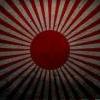





.thumb.jpg.3b9214d8c8defd1449350bd66930b2da.jpg)



.thumb.jpg.bc10b59027a00aa142dce0349f3ba9e0.jpg)
